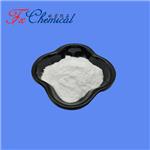
Product Details
| Product Name: 2-Deoxy-2-fluoro-D-mannose | CAS No.: 38440-79-8 |
| EC-No.: 200-001-8 | Min. Order: 10mg |
| Purity: 98% | Supply Ability: 1 |
| Release date: 2025/10/24 |
2-Deoxy-2-fluoro-D-mannose (2FDM) is a synthetic, fluorinated derivative of the natural sugar D-mannose. Here's a breakdown of its key aspects:
Chemical Structure:
The hydroxyl group (
-OH) found in natural mannose is removed (deoxy).A fluorine atom (
-F) is added in its place (fluoro).It's based on the D-mannose pyranose ring structure (a 6-membered ring).
At the carbon 2 (C2) position:
The "D" specifies the stereochemistry at C5, matching natural D-mannose.
Key Properties:
Metabolic Inhibitor: It acts as an antimetabolite of mannose. The fluorine atom mimics the size of a hydroxyl group but cannot be enzymatically processed in the same way. This disrupts specific metabolic pathways involving mannose.
Glycosylation Inhibitor: Its primary known biological effect is the inhibition of protein N-linked glycosylation, particularly the processing of oligosaccharides on glycoproteins. It interferes with enzymes like mannosidases in the Golgi apparatus.
Stability: The C-F bond is strong and stable, making the compound resistant to enzymatic degradation (like hydrolysis) that natural sugars undergo.
Isosteric Mimic: Fluorine is a good mimic for hydrogen or the oxygen of a hydroxyl group in terms of size, but its electronegativity significantly alters the electronic properties and reactivity at C2.
Primary Significance:
Glycoprotein synthesis and processing.
The role of N-linked glycosylation in protein folding, trafficking, and function.
Mannose metabolism pathways.
Research Tool: It's primarily used in biochemical and cell biological research to study:
Precursor for PET Tracers: Its most important practical application is as a key synthetic intermediate in the production of the vital PET (Positron Emission Tomography) imaging agent [¹⁸F]FDG (2-Deoxy-2-[¹⁸F]fluoro-D-glucose). While 2FDM itself isn't typically injected, it serves as a crucial building block in the radiosynthesis of FDG, which is used to image glucose metabolism in cancer, heart disease, and neurology.
Mechanism of Glycosylation Inhibition:
2FDM enters cells via glucose/mannose transporters.
It is phosphorylated by hexokinase to 2-Deoxy-2-fluoro-D-mannose-6-phosphate (2FMan-6-P).
This phosphate form accumulates in cells.
2FMan-6-P inhibits specific Golgi mannosidases (like mannosidase II) involved in trimming mannose residues from the core oligosaccharide chain during N-glycan processing. This leads to the accumulation of hybrid or high-mannose type glycans and disrupts normal glycoprotein maturation.
In summary:
2-Deoxy-2-fluoro-D-mannose is a fluorinated analog of mannose designed to disrupt mannose metabolism and, most notably, the processing of N-linked glycoproteins. While valuable as a research tool to study glycosylation, its most critical role is as an essential precursor in the synthesis of the widely used PET imaging tracer [¹⁸F]FDG. Its biological activity stems from its ability to be phosphorylated and then inhibit key enzymes in the glycan processing pathway.
Company Profile Introduction
You may like
Recommended supplier
| Product name | Price | Suppliers | Update time | |
|---|---|---|---|---|
| $0.00/10G |
VIP5Y
|
WUHAN FORTUNA CHEMICAL CO., LTD
|
2023-02-10 | |
| $10.00/25Kg |
VIP2Y
|
Xinxiang Aurora Biotechnology Co.,Ltd.
|
2025-04-24 | |
| $/ |
VIP5Y
|
RongNa Biotechnology Co.,Ltd
|
2025-04-29 | |
| $0.00/10G |
VIP5Y
|
WUHAN FORTUNA CHEMICAL CO., LTD
|
2023-02-14 | |
| $1.00/1g |
VIP6Y
|
Career Henan Chemical Co
|
2020-01-09 |
- Since: 2006-04-03
- Address: Room 2015, No.2 Building Kaixin Mansion








 China
China